Hudson River Almanac 5/19/18 - 5/25/18
The New York State Department of Environmental Conservation sent this bulletin on 06/04/2018 09:45 AM EDT |
| DEC Delivers - Information to keep you connected and informed from the NYS Department of Environmental Conservation |
| Share or view as a web page || Update preferences or unsubscribe |
|
|
OVERVIEW Many of the highlights of spring revolve around returns of wildlife from wintering locations, including fish and birds. This week the anticipated end-of-May passage of brant occurred with many thousands of these small geese heading upriver toward their Arctic breeding grounds. HIGHLIGHT OF THE WEEK
[Note: one inch = 25.4 millimeters (mm)] NATURAL HISTORY ENTRIES 5/19 – Newcomb, HRM 300: The black flies were certainly out, but were not too bad so far. We were just getting our Cloud-Splitter Outfitters operation going for spring and are waiting for the trout anglers to show, now that the Hudson River has adjusted to seasonal levels and water temperature. 5/19 – Hunter’s Brook, HRM 67.5: We picked the glass eel fyke in a cold, driving rain. The water temperature had dropped seven degrees Fahrenheit in ten days (58 degrees F). The glass eel “run” in from the sea was slowing down as we collected only 15 glass eels and six elvers. 5/20 – Minerva, HRM 284: A bunch of just-for-fun kayakers and canoeists (including children) started out in the rain heading down the beautiful Minerva Stream. It was a 90-minute slow paddle from the put-in point to the take-out point. About mid-way, in a broad, very fine, mixed swamp/marsh with lots of snags and beaver dams, we saw eight turkey vultures slowly winging around or hanging out in a few of the snags. It had been very wet, and these birds were lurking in the dead branches with their wings spread out, apparently drying them. I don't think I've seen that sort of communal wing-drying before. It reminded me of being in Florida and seeing anhinga drying their wings. [Mike Corey saw a “committee” of turkey vultures, the collective noun for the species. Such a display of spread-winged black scavengers also evokes the image of Dracula. Turkey vultures were author Edward Abbey’s favorite bird, and when he would see a kettle of them spiraling overhead, he would see them as a “convocation of undertakers.” Tom Lake] 5/20 – Greene County: We paddled across the river to bald eagle nest NY203 this morning and spotted an adult eagle on a nearby shoreline tree and another one perched on the rim of the nest. No nestlings were in sight. We watched for ten minutes without seeing anything more. There was an immature eagle on a mud flat log nearby, but it looked too much at ease to be a new fledgling. Last year NY203 produced a pair of fledglings. 5/20 – Town of Poughkeepsie: The pair of nestlings in bald eagle nest NY62, now 58 days old, welcomed “Dad” into the nest carrying a foot-and-a-half-long striped bass. The nestlings were eating well. 5/20 – Hunter’s Brook, HRM 67.5: Short shallow tributaries frequently show significant short-term changes in water temperature. A cold night or a hot day can cause it to rise or fall. Such was Hunter’s Brook when we picked the glass eel fyke net today. The water temperature had risen seven degrees F in 24-hours (65 degrees F). Our catch continued to dwindle with just eleven glass eels and three elvers.
5/21 – Coeymans Landing, HRM 133.5: In just an hour’s time, I watched six flocks of brant, 1,225 birds, pass over Schodack Island heading north.
5/21 – Ulster Park, HRM 87: For at least three hours this evening, I watched, non-stop, huge flocks of brant flying up the river. I must have seen at least a dozen flocks with thousands of birds. [Waterman Dery Bennett used to mark the seasons by noting how brant (Branta bernicla), a small species of goose, left Sandy Hook, NJ, around Memorial Day after spending the winter, and headed north. In his words, “They would shove off for the Canadian Arctic where they breed, fledge young, and then return around Columbus Day.” Tom Lake] 5/21 – Norrie Point, HRM 85: The cove at Norrie Point was getting shallow as the tide receded. Fifty 6th graders from Kinry Road Middle School were with us to help sample the Hudson River’s aquatic life. Before we even wet our net, we counted six northern water snakes (Nerodia sipedon) slithering through the shallow with just their heads out of the water. Despite being a harmless, non-venomous snake, the students were spooked. As for the fish we caught, they included pumpkinseeds, redbreast sunfish, bluegills, spottail shiners, tessellated darters, white perch, and both male and female banded killifish. The river was 65 degrees F. 5/21 – Beacon, HRM 61: It was a bountiful day carp fishing. While none of them were big, I ended up catching and releasing seven. I did not weigh any of them but I estimated they ranged from 2-8 pounds. I lost several others between hookup and landing. Any day one catches more than two carp is a big deal. For the first time this season, I saw carp breaking the surface indicating the onset of their spawning season. Finally, Kudos to Scenic Hudson. They cleared the storm-wrought fallen tree disaster on the Long Dock trail to the river. [If Bill Greene’s stories of fishing for huge common carp piques your interest, consider coming to our hands-on seminar on carp fishing, Saturday, June 9, 9:00 AM to noon, at the Norrie Point Environmental Education Center in Staatsburg, sponsored by the Carp Anglers Group. See our Spring Programs list for more information. Tom Lake] 5/21 – Bedford, HRM 35: The great blue heron rookery was a bit noisy with their collective vocalizing that sounded like chatter. Two nests had four very active nestlings without an adult guardian present. It would take a lot of food to feed those nestlings with both parents out hunting to keep up with their appetites. The other nests had a guardian present with nestlings only partly visible. Soon they will all be large enough to be seen. 5/21 –Yonkers, HRM 18: We had 35 preschoolers from the Eliza Corwin Frost School today at the Sarah Lawrence College Center for the Urban River at Beczak to learn about the river life in the Hudson. We caught four kinds of fish, including American eel, summer flounder, mummichog, and white perch. Among the crustaceans were shore shrimp and half-a-dozen blue crabs.
5/22 – Yonkers, HRM 18: A second grade class from Bank Street School in Manhattan joined us today at the Sarah Lawrence College Center for the Urban River at Beczak. Our seine caused much excitement when we beached it with five kinds of fish, including striped bass, northern pipefish, mummichog, and Atlantic tomcod. In the back of the net, we also found ten blue crabs and five shore shrimp. 5/23 – Esopus Meadows, HRM 87: Among our seining catch today, in the near shore shallows off Esopus Meadows, was an Oriental weatherfish (Misgurnus anguillicaudatus). The weatherfish probably came from a nearby tributary, the Esopus Klyne Kill, where it has been found. Oriental weatherfish are native to eastern Asia, were introduced into the United States in California in 1968, and were first reported in New York in 2009 by Doug Carlson from the Dwaarkill, a tributary of the Wallkill River.
[Rudd (Scardinius erythrophthalmus) are a large, introduced European minnow that have been in the Hudson watershed since the 1920s and seem to be getting more common in the estuary. It is a stubby, deep-bodied fish, with really bright red fins including the tail. Bob Schmidt] 5/23 – Millbrook, HRM 82: One of the signs of the waning spring season is the appearance of Dame’s rocket (Hesperis matronalis) in the uplands and along the river. This naturalized wildflower, native to Eurasia and brought to North America in the 17th century, comes in white, pink, violet, and purple. Carried by spring breezes, its wonderfully sweet fragrance fills the air from mid-May through early June. 5/23 – Fort Montgomery, HRM 46.5: I watched the Hudson River Sloop Clearwater glide past as I walked down to Mine Dock Park. A small lizard with a blue tail ran past me. It was my first skink of the season. [Five-lined skinks (Plestiodon fasciatus) are small lizards, less than nine inches long, and are not rare in the lower Hudson Valley. The bright blue tail of the immature may serve as a survival strategy: Predators grabbing the skink by its colorful tail will find that it breaks off. The skink escapes, and eventually it will regenerate another tail. Tom Lake] 5/23 – Yonkers, HRM 18: A second grade class from Bank Street in Manhattan, a twin to the one that visited yesterday, arrived at the Sarah Lawrence College Center for the Urban River at Beczak with much anticipation. We hauled our seine and caught five kinds of fish as we did yesterday, including American eel, bay anchovy, Atlantic tomcod, mummichog, and northern pipefish. But this class caught twice as many blues crabs (20) and more than three times as many shrimp (18). 5/24 – Town of Poughkeepsie: The two nestlings in bald eagle nest NY62, now 62 days old, were on the verge of “branching,” expanding their world in the nest tree. Sharing the forest edge were three Baltimore orioles, singing and flashing color. Aldo Leopold described the oriole’s flash as, “like a burst of fire.” 5/24 – Beacon, HRM 61: The river was a warm 75 degrees F, shorts and sandals weather. We hauled our seine with little expectations – in the absence of young-of-the-year fishes, spring can be a difficult time. As we beached the net we were surprised to see many glass eels and elvers, juvenile American eels, wiggling their way back into the swash after escaping our quarter-inch mesh. Beyond that, our highlight was several male banded killifish. [There may not be a prettier fish in the river than a courting male banded killifish with iridescent blue, lavender, and silver highlights in their bands. A fitting name for the male is “blue-banded mudminnow,” a colloquialism coined by riverman Everett Nack. The females, a drab brownish-green, are a good example of sexual dimorphism. Tom Lake] 5/25 –Town of Poughkeepsie: The two nestlings in bald eagle nest NY62, now 63 days old, were very active, stretching their wings and probably wondering what they are all about. In another two weeks, they will be within range of anticipated fledge dates (72-90 days).
SPRING 2018 NATURAL HISTORY PROGRAMS Free Trees for Streamside Planting For more information about the program or to download an application, please visit the DEC website at: www.dec.ny.gov/lands/43668.html . If you have questions about a potential planting site, please contact Beth Roessler at (845) 256-2253 or HudsonEstuaryTFT@dec.ny.gov. - Here’s how it works: Fill out a logbook provided by us whenever you fish on the Hudson River (by boat or shore). Record general location, time, gear used, what you caught (or if you didn’t catch anything) and return the logbook when you are done fishing. You’ll receive an annual newsletter summarizing the information in addition to the latest news regarding regulations and the river. - Whether you catch-and-release or take home a keeper, you can be part of the Cooperative Angler Program. Join today by contacting: Jessica Best 845-256-3009 jessica.best@dec.ny.gov HUDSON RIVER MILES The Hudson is measured north from Hudson River Mile 0 at the Battery at the southern tip of Manhattan. The George Washington Bridge is at HRM 12, the Tappan Zee 28, Bear Mountain 47, Beacon-Newburgh 62, Mid-Hudson 75, Kingston-Rhinecliff 95, Rip Van Winkle 114, and the Federal Dam at Troy, the head of tidewater, at 153. The tidal section of the Hudson constitutes a bit less than half the total distance – 315 miles – from Lake Tear of the Clouds to the Battery. Entries from points east and west in the watershed reference the corresponding river mile on the mainstem. TO CONTRIBUTE YOUR OBSERVATIONS OR TO SUBSCRIBE The Hudson River Almanac is compiled and edited by Tom Lake and emailed weekly by DEC's Hudson River Estuary Program. Share your observations by e-mailing them to trlake7@aol.com. To subscribe to the Almanac (or to unsubscribe), use the links on DEC's Hudson River Almanac or DEC Delivers web pages. Discover New York State Conservationist - the award-winning, advertisement-free magazine focusing on New York State's great outdoors and natural resources. Conservationist features stunning photography, informative articles and around-the-state coverage. Visit the Conservationist webpage for more information. USEFUL LINKS National Oceanic and Atmospheric Administration online tide and tidal current predictions are invaluable when planning Hudson River field trips. For real-time information on Hudson River tides, weather and water conditions from sixteen monitoring stations, visit the Hudson River Environmental Conditions Observing System website. NY Open for Hunting and Fishing Initiative: Under Governor Cuomo's Adventure NY initiative, DEC is making strategic investments to expand access to healthy, active outdoor recreation, connect more New Yorkers and visitors to nature and the outdoors, protect natural resources, and boost local economies. This initiative will support the completion of more than 75 projects over the next three years, ranging from improvements to youth camps and environmental education centers to new boat launches, duck blinds, and hiking trails. Read more about the Adventure NY initiative. For more information on planning an outdoor adventure in New York State, visit DEC's website at http://www.dec.ny.gov/outdoor. Information about the Hudson River Estuary Program is available on DEC's website at http://www.dec.ny.gov/lands/4920.html. Copies of past issues of the Hudson River Almanac, Volumes II-VIII, are available for purchase from the publisher, Purple Mountain Press, (800) 325-2665, or email purple@catskill.net |

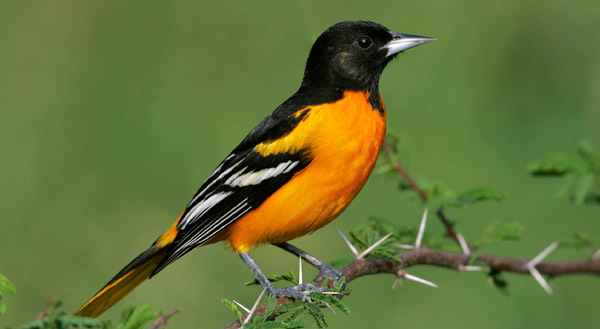 Hudson River Almanac
Hudson River Almanac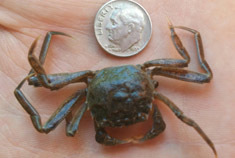 5/22 – Norrie Point, HRM 85: Two classes of 5th graders from Wappinger Junior High helped us sample the river life in the cove at Norrie Point. We caught the local fish species including American eels, banded killifish, tessellated darters, and pumpkinseed sunfish. There was also a puzzler, a small dark crab the size of a dime. A closer look under a hand lens revealed it to be a white-fingered mud crab. The water temperature was 63 degrees Fahrenheit (F). (Photo of white-fingered mud crab courtesy of Tom Lake)
5/22 – Norrie Point, HRM 85: Two classes of 5th graders from Wappinger Junior High helped us sample the river life in the cove at Norrie Point. We caught the local fish species including American eels, banded killifish, tessellated darters, and pumpkinseed sunfish. There was also a puzzler, a small dark crab the size of a dime. A closer look under a hand lens revealed it to be a white-fingered mud crab. The water temperature was 63 degrees Fahrenheit (F). (Photo of white-fingered mud crab courtesy of Tom Lake)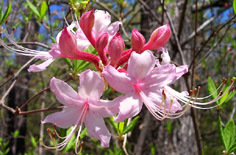 5/20 – Brooklyn, New York City: The Pinxterbloom azalea (Rhododendron periclymenoides), a spectacular pink-and-white confection, bloomed today. The common name is derived from the Dutch name for Pentecost, one of the three great feasts of the Christian year. It comes fifty days after Easter (actually forty-nine since it’s always on a Sunday) and the Dutch, for whom it was a major holiday, brought it to New York. By the early nineteenth century, it had become primarily a holiday for both enslaved and free African-Americans in the Hudson Valley, a day off to meet relatives and friends. (Photo of pinxterbloom azalea courtesy of Bill Tanneberger)
5/20 – Brooklyn, New York City: The Pinxterbloom azalea (Rhododendron periclymenoides), a spectacular pink-and-white confection, bloomed today. The common name is derived from the Dutch name for Pentecost, one of the three great feasts of the Christian year. It comes fifty days after Easter (actually forty-nine since it’s always on a Sunday) and the Dutch, for whom it was a major holiday, brought it to New York. By the early nineteenth century, it had become primarily a holiday for both enslaved and free African-Americans in the Hudson Valley, a day off to meet relatives and friends. (Photo of pinxterbloom azalea courtesy of Bill Tanneberger)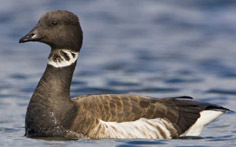 5/21 – Ulster County, HRM 88: While fishing for striped bass this evening about a mile north of the Esopus Meadows Lighthouse, there was an almost nonstop movement of brant moving upriver. Most of the flocks contained several hundred birds. Unfortunately, the striped bass were beginning to spawn and were not very interested in feeding. We caught and released one fish about 20 pounds. (Photo of brant courtesy of Doug Wechsler)
5/21 – Ulster County, HRM 88: While fishing for striped bass this evening about a mile north of the Esopus Meadows Lighthouse, there was an almost nonstop movement of brant moving upriver. Most of the flocks contained several hundred birds. Unfortunately, the striped bass were beginning to spawn and were not very interested in feeding. We caught and released one fish about 20 pounds. (Photo of brant courtesy of Doug Wechsler)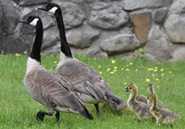 5/22 – Beacon, HRM 61: It was the season for hen Canada geese and their goslings. More than a dozen fuzzy goslings paraded around Long Dock in the company of the hens. It was not easy to discern which goslings belonged to which hen. It seemed like a community day-care arrangement. (Photo of canada geese and goslings courtesy of Brenda Miller)
5/22 – Beacon, HRM 61: It was the season for hen Canada geese and their goslings. More than a dozen fuzzy goslings paraded around Long Dock in the company of the hens. It was not easy to discern which goslings belonged to which hen. It seemed like a community day-care arrangement. (Photo of canada geese and goslings courtesy of Brenda Miller) 5/23 – Norrie Point, HRM 85: It is on days like these that I recall a research axiom from my college ecology courses: “No data is still data.” We had fifty 7th graders from Wappinger Junior High to help us sample the river life in the cove at Norrie Point. The tide was perfect, yet after ten hauls of our seine, we had not caught a single fish. We had lunch, the tide fell a little, the sky brightened, and the fish came back. On the last haul of the day we caught seven fish, the most interesting of which were three rudd (60-90 mm). The axiom was shelved for another day. (Photo of rudd courtesy of Tom Lake)
5/23 – Norrie Point, HRM 85: It is on days like these that I recall a research axiom from my college ecology courses: “No data is still data.” We had fifty 7th graders from Wappinger Junior High to help us sample the river life in the cove at Norrie Point. The tide was perfect, yet after ten hauls of our seine, we had not caught a single fish. We had lunch, the tide fell a little, the sky brightened, and the fish came back. On the last haul of the day we caught seven fish, the most interesting of which were three rudd (60-90 mm). The axiom was shelved for another day. (Photo of rudd courtesy of Tom Lake)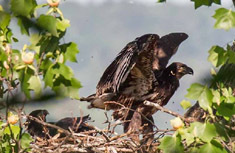 5/25 – Town of Wappinger, HRM 67: If you are able to be up and about just before dawn at this time of the year, about 5:00 AM, you might want to emulate one of Aldo Leopold’s favorite activities. In his classic natural history volume, A Sand County Almanac, Leopold writes of stepping from his cabin door in Wisconsin just before dawn with coffee pot and notebook in hand, and sitting on a bench facing the morning star. As first light appeared, he recorded the order of awakening songbirds, as field sparrow, robin, oriole, indigo bunting, wren, grosbeak, thrasher, yellow warbler, bluebird, vireo, towhee, and cardinal, as they all, “explode into song” and now, “all is bedlam.” (Photo of bald eagles nestlings courtesy of Bob Rightmyer)
5/25 – Town of Wappinger, HRM 67: If you are able to be up and about just before dawn at this time of the year, about 5:00 AM, you might want to emulate one of Aldo Leopold’s favorite activities. In his classic natural history volume, A Sand County Almanac, Leopold writes of stepping from his cabin door in Wisconsin just before dawn with coffee pot and notebook in hand, and sitting on a bench facing the morning star. As first light appeared, he recorded the order of awakening songbirds, as field sparrow, robin, oriole, indigo bunting, wren, grosbeak, thrasher, yellow warbler, bluebird, vireo, towhee, and cardinal, as they all, “explode into song” and now, “all is bedlam.” (Photo of bald eagles nestlings courtesy of Bob Rightmyer)